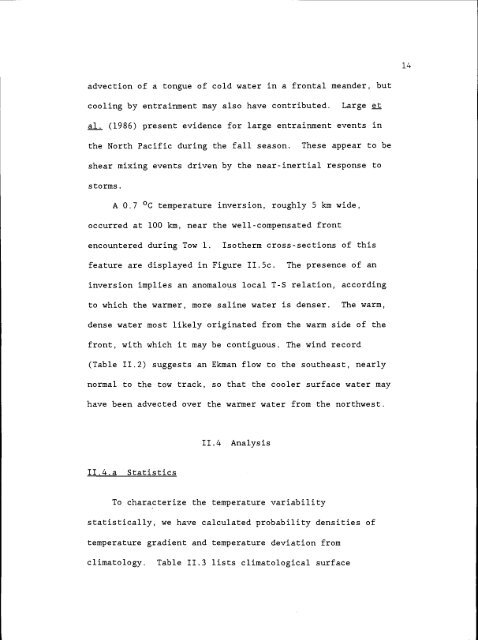Observations and Modelling of Fronts and Frontogenesis
Observations and Modelling of Fronts and Frontogenesis
Observations and Modelling of Fronts and Frontogenesis
You also want an ePaper? Increase the reach of your titles
YUMPU automatically turns print PDFs into web optimized ePapers that Google loves.
advection <strong>of</strong> a tongue <strong>of</strong> cold water in a frontal me<strong>and</strong>er, but<br />
cooling by entrainment may also have contributed. Large<br />
(1986) present evidence for large entrainment events in<br />
the North Pacific during the fall season. These appear to be<br />
shear mixing events driven by the near-inertial response to<br />
storms.<br />
A 0.7 °C temperature inversion, roughly 5 kin wide,<br />
occurred at 100 kin, near the well-compensated front<br />
encountered during Tow 1. Isotherm cross-sections <strong>of</strong> this<br />
feature are displayed in Figure II,5c. The presence <strong>of</strong> an<br />
inversion implies an anomalous local T-S relation, according<br />
to which the warmer, more saline water is denser. The warm,<br />
dense water most likely originated from the warm side <strong>of</strong> the<br />
front, with which it may be contiguous. The wind record<br />
(Table 11.2) suggests an Ekman flow to the southeast, nearly<br />
normal to the tow track, so that the cooler surface water may<br />
have been advected over the warmer water from the northwest.<br />
II.4.a Statistics<br />
11.4 Analysis<br />
To characterize the temperature variability<br />
statistically, we have calculated probability densities <strong>of</strong><br />
temperature gradient <strong>and</strong> temperature deviation from<br />
climatology. Table 11.3 lists climatological surface<br />
14















